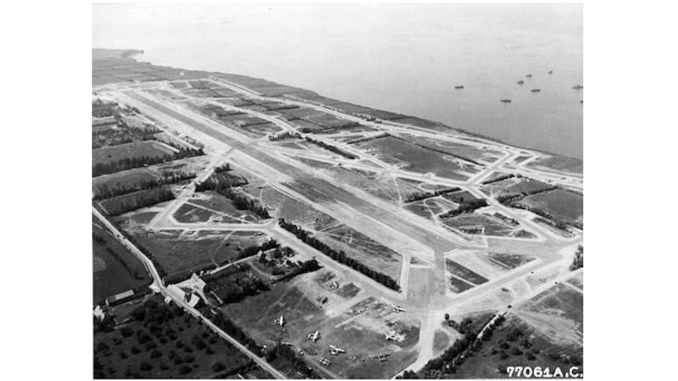
Operational airfields were high on the Normandy invasion priority list. So high, in fact, that construction equipment was brought ashore on 6 June 1944 specifically to build an emergency landing strip (ELS) for any Allied aircraft in trouble and unable to make it back across the Channel to England. Designated ELS-1, the 2,000 foot sod strip was built in hours by combat engineers, near the village of Poupeville, about 2 miles inland from Utah beach: it was ready to use on D-Day. ELS-1 was the first of many temporary airfields known as Advanced Landing Ground (ALG).
Construction on the second Normandy ALG began almost as quickly. Located above the cliffs between Omaha Beach and Pointe Du Hoc, near the village of Saint-Pierre-du-Mont, work began on 7 June. By 8 June, 1800 hours, it was ready to serve as an ELS. ALG A-1 became operational five days later on 13 June 1944. The 5,000 runway was more than just a dirt landing strip, though. Engineers had laid down Square-Mesh Track (SMT), a temporary metal landing strip meant to provide something more substantial than dirt and to mitigate mud, a bane to aircraft operations. There were no permanent buildings, just tents for shelter, workshops, and offices. Immediately, C-47 cargo planes began delivering ammunition and supplies from England, and carrying the wounded back to hospitals on the return trip. Just as important, A-1 became home to squadrons of P-38 Lightnings and P-47 Thunderbolts. Most fighter aircraft of the day had limited range, though the P-51 Mustang was a well-known exception. By basing Lightnings and Thunderbolts close to the front lines, their effectiveness greatly improved: they were able to get to the action quicker, loiter in a combat area longer, hit more ground targets faster, and provide protective air cover above the ALG longer. This was no insignificant advantage. It’s said that P-47s alone destroyed approximately 9,000 locomotives, 86,000 railroad cars, 6,000 armored fighting vehicles (including tanks), and 68,000 trucks in its role as a ground attack aircraft.
The British also built ALGs. One of their first, designated B-2, was near the village of Bazenville, just inland from the landing beaches. Construction began just after midnight, 7 June. A B-24 Liberator heavy bomber crashed there on 9 June, shortly before the airfield was ready for aircraft landings. The bomber tore up the SMT, forcing repairs and a delay until 11 June before operations could begin. Spitfires, another fighter with notoriously short range, were assigned to B-2, and C-47 Dakotas were regular visitors, as they were at all forward operating bases.
As the Normandy beachhead grew, dozens more ALGs were built. Once the Allies broke out of Normandy and began moving swiftly across France, many more ALGs were built close to the front lines. It was very important that the temporary airfields kept up with the advancing armies since aircraft could resupply troops with ammunition and fuel for tanks and other vehicles much quicker than ground-based supply lines. Whenever a Luftwaffe airfield was captured, it was repaired and reopened as an ALG.
Airpower and logistics (getting ammunition and supplies to the soldiers who need it most) were crucial components of the Allies’ plan to defeat Germany. The hundreds of ALGs that were built in France and Germany and other European countries contributed immeasurably to that plan. Most ALGs were closed and the land returned to their owners after the war. Some still exist today, having been transformed into NATO bases or civilian airports.
The only decent video I could find regarding ALGs is this British Pathé silent newsreel of UK soldiers building a temporary airstrip somewhere in the Normandy beachhead. “Making Airfield After D-Day Landings (1944)” (10:41):
Question Of The Night: By pressing a reset button, you can erase any song or tune from history and the collective memory… which would it be?
